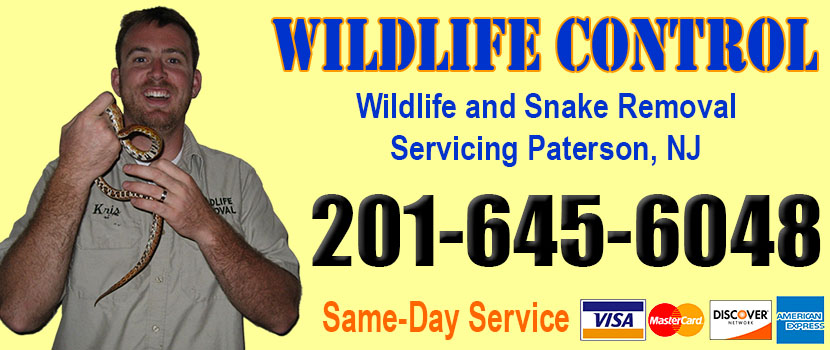
Welcome to patersonsnakes.com! I am David, a snake enthusiast living in Paterson, NJ. Many people don't know that Paterson is in fact full of snakes! You just need to know where to find them - they can often be shy and elusive. Some New Jersey snake species are more common outside of the city limits, in different parts of Passiac County NJ, but many types of snakes are indeed common in the more urban parts of Paterson. This guide is meant to help educate you about the beautiful snakes of Paterson, and to help you identify the most common snakes of Paterson, as well as the venomous snakes of Paterson that you should learn to recognize and avoid. If you want more detail, click here for my complete list of ALL snake species in Paterson. Remember the following:
- Most snakes of Paterson are harmless and don't want to encounter you
- Venomous snakes exist but are uncommon in Paterson, New Jersey
- Snakes eat rats and mice and are a valuable part of the New Jersey ecosystem
- Never kill a snake - if you leave a snake alone, it will leave you alone.
Common Snake Species in Paterson
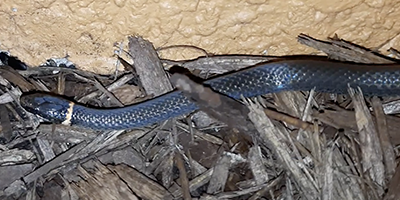 Southern Ringneck Snake:
When it comes to snakes that you are most likely to come across in Paterson New Jersey, the southern ringneck snake is at the top of the list. With a striking resemblance to its cousin the northern ringneck snake, these snakes are quite common in this city.
The only feature that differentiates the two is the presence of dark mark cuttings along the neck ring of the southern ringneck snake and also the presence of dark half-moon patterns which usually run through the midline of the snake. This species of snake also has smooth scales and can be found in moist habitats where they have abundant access to frogs, toads, lizards, and other small animals.
Southern Ringneck Snake:
When it comes to snakes that you are most likely to come across in Paterson New Jersey, the southern ringneck snake is at the top of the list. With a striking resemblance to its cousin the northern ringneck snake, these snakes are quite common in this city.
The only feature that differentiates the two is the presence of dark mark cuttings along the neck ring of the southern ringneck snake and also the presence of dark half-moon patterns which usually run through the midline of the snake. This species of snake also has smooth scales and can be found in moist habitats where they have abundant access to frogs, toads, lizards, and other small animals.
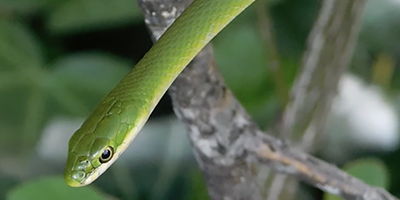 Smooth Green Snake:
These are relatively small snakes with an average length of 8 to 26 inches. They are primarily found in grasses, open woods, meadows, and other terrestrial habitats where they can easily blend into without getting noticed. Unlike their cousins the rough green snake, these snakes don't show the ability to be able to climb trees.
Just as their name implies, smooth green snakes have smooth light green scales with a yellow, white, or pale green belly. The only advantage that this snake has over its prey and predators is its ability to camouflage effectively.
Smooth Green Snake:
These are relatively small snakes with an average length of 8 to 26 inches. They are primarily found in grasses, open woods, meadows, and other terrestrial habitats where they can easily blend into without getting noticed. Unlike their cousins the rough green snake, these snakes don't show the ability to be able to climb trees.
Just as their name implies, smooth green snakes have smooth light green scales with a yellow, white, or pale green belly. The only advantage that this snake has over its prey and predators is its ability to camouflage effectively.
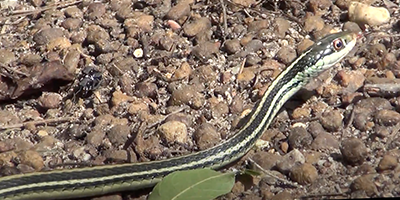 Eastern Ribbon Snake:
The eastern ribbon snake is another snake you are most likely going to come across in this city. They are slender snakes with long tails and side stripes. The color of this snake is usually brown or black with bright yellow stripes. The underside of the snake is usually pale green or yellow with a brown stripe along the edge of the belly.
Unlike other snakes, they have keeled scales and are fast-moving snakes with excellent hunting abilities. Being a moisture-loving snake, you will tend to find it around streams, bogs, and swamps
Eastern Ribbon Snake:
The eastern ribbon snake is another snake you are most likely going to come across in this city. They are slender snakes with long tails and side stripes. The color of this snake is usually brown or black with bright yellow stripes. The underside of the snake is usually pale green or yellow with a brown stripe along the edge of the belly.
Unlike other snakes, they have keeled scales and are fast-moving snakes with excellent hunting abilities. Being a moisture-loving snake, you will tend to find it around streams, bogs, and swamps
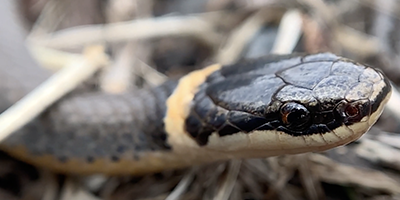 Northern Ringneck Snake:
Here is another common snake in Paterson New Jersey that people encounter at all times. This snake has smooth scales with a black body that has a golden neck collar. The underbelly of the snake is usually yellow with black dots.
Northern Ringneck Snake:
Here is another common snake in Paterson New Jersey that people encounter at all times. This snake has smooth scales with a black body that has a golden neck collar. The underbelly of the snake is usually yellow with black dots. Venomous Snake Species in Paterson
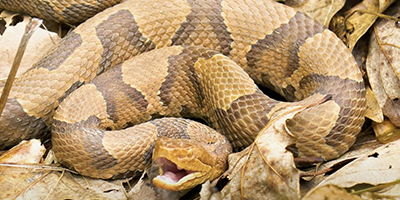 Northern Copperhead:
New Jersey has many snakes that are not harmful, but you need to stay away from this particular snake. The northern copperhead snake is a venomous snake you are most likely going to run into if you go hiking. This species of snake inhabits farmlands, rocky fields, woodlands, and old mulch pipes. This simply means that there is also a high tendency of you finding this snake in your home or surroundings.
Northern copperhead snakes can be in different forms because they are always in two different shades which is usually reddish-brown or copper. The presence of a light background on the skin of the snake enables the dark patterns to form an hourglass shape with a wide band on the side and narrow ones at the back of the snake.
Despite being a venomous snake, no human death has been associated with a northern copperhead snake bite. They are slow to attack and will only strike if threatened.
Northern Copperhead:
New Jersey has many snakes that are not harmful, but you need to stay away from this particular snake. The northern copperhead snake is a venomous snake you are most likely going to run into if you go hiking. This species of snake inhabits farmlands, rocky fields, woodlands, and old mulch pipes. This simply means that there is also a high tendency of you finding this snake in your home or surroundings.
Northern copperhead snakes can be in different forms because they are always in two different shades which is usually reddish-brown or copper. The presence of a light background on the skin of the snake enables the dark patterns to form an hourglass shape with a wide band on the side and narrow ones at the back of the snake.
Despite being a venomous snake, no human death has been associated with a northern copperhead snake bite. They are slow to attack and will only strike if threatened.
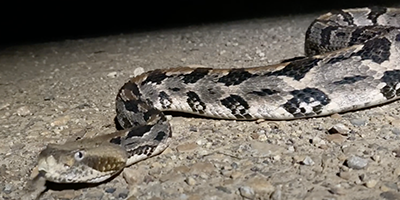 Timber Rattlesnake:
The timber rattlesnake is one of the two known snakes in New Jersey that are venomous. These snakes are common in areas with dense forests, woody areas, and rocky areas. Just like the copperhead snake described above, they come in two color phases, the yellow and the black phase. The yellow phase has a yellowish to brownish ground color with V-shaped blotches or bands around the head region. While the black has a similar pattern to the latter. The only difference is that the background color of the snakeskin is black.
Timber Rattlesnake:
The timber rattlesnake is one of the two known snakes in New Jersey that are venomous. These snakes are common in areas with dense forests, woody areas, and rocky areas. Just like the copperhead snake described above, they come in two color phases, the yellow and the black phase. The yellow phase has a yellowish to brownish ground color with V-shaped blotches or bands around the head region. While the black has a similar pattern to the latter. The only difference is that the background color of the snakeskin is black.If you're unsure, you can email me a photo of the snake at info@patersonsnakes.com and I will email you back with the snake's species. If you found a snake skin, read my Found a Skin? page, and you can email me a photo of the skin, and I'll identify the snake for you. If you need professional Paterson snake removal help, click my Get Help page, or see the below website sponsor I found, who provides that service.
How Do Snakes Produce Their Venom?
The venom of the snakes will vary a lot in terms of their effect and composition. This fact has posed a challenge in developing the antivenin. Snakes' venom will be useful when foraging; they can use this to subdue their prey. It is also a part of their defense mechanism to keep them safe from a terrifying predator. This is why thousands of people who are trying to capture them will be bitten by snakes annually.
How Are Snakes Producing Their Venom?
The snakes' venom is produced by a unique gland that evolves from the average salivary gland. A standard form of saliva will include enzymes that will help us digest food better. With the snakes, it contains a toxic compound that will dissolve the meal at a faster rate. Based on the researchers at Bangor University, the venom found on King Cobra contains a modified form of the ordinary proteins. However, their prey also has evolved over the years. Some of them are also showing a strong immunity to venoms. They can now combine a mixture of 50-100 types of proteins that can change the blood pressure, paralyze the nerve, prevent blood coagulation, and destroy cells.
How Do Snakes Deliver Their Venom?
Most of the snakes will be injecting their venom through their fangs. It is quite practical to use their fangs since they are sharp enough to pierce through the tissue and encourage the venom to flow into the wound. Some snakes can spit their venom. The injection system of the snake will include the fangs, ducts, muscles, and the venom gland.
Fangs- It is a modified form of teeth that comes with channels that allow the venom to flow through.
Ducts- It provides the path for the efficient transport of the venom from the glands and into the snake's fang.
Muscles- The snake's muscles also play a vital role in the proper delivery of the venom. Without this, the venom from the gland will not be efficiently squeezed out.
Venom Gland- It is a unique gland found in the head of the snakes that stores the venom.
What Are the Different Types of Venom?
While the snakes' venom is a highly complex combination of different toxic substances, they can still be categorized into three types; hemotoxins, cytotoxins, and neurotoxins. Hemotoxins are hazardous to the blood. It destroys the red blood cells that will prevent the blood from clotting, eventually leading to internal bleeding. Cytotoxins can dissolve the cells. It will lead to a condition known as necrosis or the death of the cells. Neurotoxins affect the victim's nervous system. They disrupt the chemical cues being sent to the brain and may cause paralysis. The victim may experience difficulty in breathing that may eventually lead to their death.
It is quite fascinating to know how snakes are so effective in defending themselves and in foraging foods. They can even control the dose of venom that they will inject. If a venomous snake has bitten you, antivenin must be administered immediately to prevent the situation from worsening.
Remember, the term is not poisonous snakes of Paterson, it's venomous snakes of Paterson. Poison is generally something you eat, and venom is injected into you. That said, dangerous snakes are very rare in Paterson. The few venomous snakes of Passiac County are rarely seen. But they are commonly misidentified, so learn about all the snake species of Paterson in order to correctly identify them. These snakes are usually also found in the surrounding towns of Paterson, Passaic, Clifton, Wayne, West Milford, Little Falls, Wanaque, Totowa, Ringwood, Hawthorne, Woodland Park, Pompton Lakes, North Haledon, Bloomingdale, Haledon, Prospect Park, and the surrounding areas.
Read our article about:
Ways to Get the Snake Out of the Attic
patersonsnakes.com domain and hosting costs made possible by the generous support of this sponsor:
